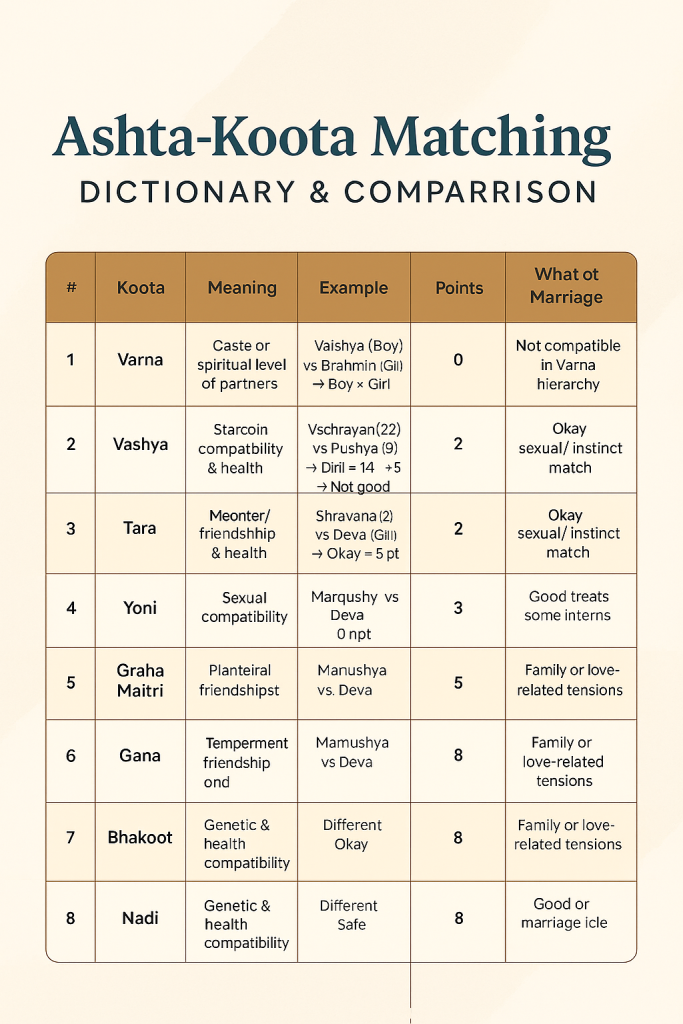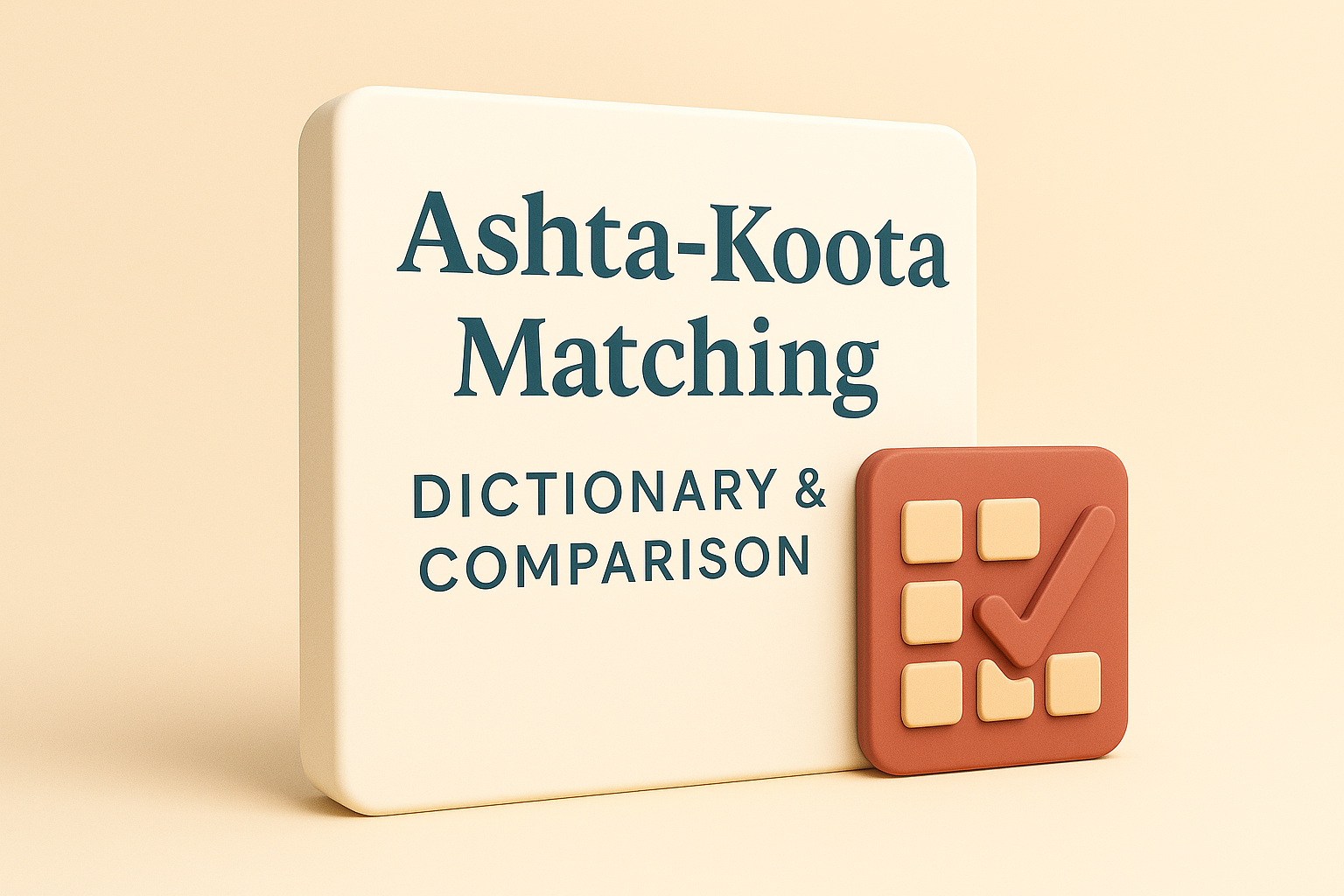To check the compatibility of the bride (Behuli) and groom (Behula) before marriage through Ashtakoota Milan, which assigns a maximum of 36 points (guna) based on 8 key factors.
The 8 Kootas (Ashtakoota System)
| Koota | Description | Max Points | Basis |
|---|---|---|---|
| 1. Varna | Spiritual compatibility (dharma) | 1 | Moon sign classification (Brahmin, etc.) |
| 2. Vashya | Mutual attraction, control | 2 | Moon sign interaction |
| 3. Tara | Health, longevity | 3 | Birth stars (Nakshatra) |
| 4. Yoni | Sexual compatibility | 4 | Nakshatra animal symbolism |
| 5. Graha Maitri | Mental compatibility | 5 | Moon sign lords (planetary friendship) |
| 6. Gana | Nature compatibility | 6 | Nakshatra temperament (Deva, Manushya, Rakshasa) |
| 7. Bhakoot | Emotional bonding, prosperity | 7 | Moon sign position difference |
| 8. Nadi | Genetic compatibility, health of children | 8 | Nakshatra division (Aadi, Madhya, Antya) |
Total = 36 Points (Gun)
Detailed Logic with Mathematics
1. Varna (1 Point)
- Categories: Brahmin > Kshatriya > Vaishya > Shudra
- If boy’s Varna ≥ girl’s Varna → 1 point, else 0
Logic:
points_varna = (varna_boy >= varna_girl) ? 1 : 0;2. Vashya (2 Points)
- Types: Chatushpada (Quadruped), Dwipada (Human), Jalchar (Aquatic), Vanachari (Wild), Keet (Insect)
- Matching chart defines compatibility
Example:
- Same type → 2 points
- Compatible type → 1 point
- Incompatible → 0
points_vashya = vashyaChart[boy_vashya][girl_vashya];3. Tara (3 Points)
- Based on Nakshatra distance (star compatibility)
- Use birth Nakshatra number of boy (Nb) and girl (Ng)
- Formula:
remainder=abs(Nb−Ng)remainder = abs(Nb – Ng) % 9 remainder=abs(Nb−Ng)
- If remainder ∈ [1, 3, 5, 7] → Not auspicious → 0 or 1 point
- Max 3 points if completely compatible
4. Yoni (4 Points)
- Nakshatras are associated with animals
- Check animal compatibility (same animal, friends, enemies)
- Same yoni → 4
- Friendly → 3
- Neutral → 2
- Hostile → 0
Logic:
points_yoni = yoniCompatibility[boy_yoni][girl_yoni];5. Graha Maitri (5 Points)
- Based on friendship between Moon lords
- If lords are friends → 5
- Neutral → 3
- Enemy → 0
Logic:
points_graha = grahaFriendship[moonLord_boy][moonLord_girl];
6. Gana (6 Points)
- Deva (Divine), Manushya (Human), Rakshasa (Demonic)
- If both same → 6
- Deva/Manushya → 5
- Rakshasa with Deva/Manushya → 1 or 0 (bad match)
7. Bhakoot (7 Points)
- Moon sign (Rashi) distance
- Check the difference (D) in signs:
D=abs(signboy−signgirl)D = abs(sign_boy – sign_girl) D=abs(signboy−signgirl)
- Auspicious if D ∈ [1, 3, 6, 7, 10, 11]
- Inauspicious if D ∈ [2, 5, 9, 12] → 0
Bhakoot dosha is serious if present.
8. Nadi (8 Points)
- Nadi: Aadi, Madhya, Antya
- If same Nadi → 0 (Dosha)
- Different → 8
Most important; if Nadi is same, marriage is typically not recommended unless exceptions apply.
Total Score Calculation
totalPoints = points_varna +
points_vashya +
points_tara +
points_yoni +
points_graha +
points_gana +
points_bhakoot +
points_nadi;
Compatibility Result
| Score | Result |
|---|---|
| 32-36 | Excellent match (Highly compatible) |
| 25-31 | Good match |
| 18-24 | Average match (Needs caution) |
| <18 | Poor match (Not recommended) |
Required Input:
- Boy and Girl Rashi (Moon sign)
- Boy and Girl Nakshatra
- Planetary data to find:
- Nakshatra number
- Moon lord
- Gana
- Nadi
- Yoni animal
- Vashya
- Varna
You can calculate these using
ephemerisdata from Panchang or APIs like Swiss Ephemeris (swisseph) or Maitreya Astrosoft, or libraries likeastronomy-engineorvedic-astrology-js.
4. Example-Based Explanation (Behula & Behuli)Let’s take a Nepali example:
Behula (Boy): Rashi = Makar, Nakshatra = Shravana
Behuli (Girl): Rashi = Karkat, Nakshatra = PushyaNow Match 8 Kootas:
Koota Matching Result Points Varna Vaishya vs Brahmin Boy < Girl → 0 pt 0 Vashya Makar vs Karkat Neutral → 1 pt 1 Tara Shravana (22) vs Pushya (8) → Diff = 14 → 14%9=5 → Not good 1 Yoni Monkey vs Goat Neutral → 2 pt 2 Graha Maitri Moon (Shani) vs Moon (Chandra) → Enemy 0 Gana Manushya vs Deva Okay → 5 pt 5 Bhakoot Makar (10) vs Karkat (4) → 6th position → Bad 0 Nadi Different (Aadi vs Madhya) → Safe 8 Total Points = 0 + 1 + 1 + 2 + 0 + 5 + 0 + 8 = 17 / 36
Result:
Poor match. Further remedies or alternatives recommended.
so what does this mean
Ashta-Koota Matching Dictionary & Comparison Table
# Koota Name Meaning Example Points What It Means Effect on Marriage 1 Varna (वर्ण) Caste or spiritual level of partners (spiritual compatibility) Vaishya (Boy) vs Brahmin (Girl) → Boy < Girl → 0 pt 0 / 1 Not compatible in Varna hierarchy Ego clash or respect imbalance 2 Vashya (वश्य) Ability to control/influence partner (mental & emotional control) Makar (Boy) vs Karkat (Girl) → Neutral → 1 pt 1 / 2 Average influence on each other Balanced or mutual influence 3 Tara (तारा) Star compatibility and health factors Shravana (22) vs Pushya (8) → Diff = 14 → 14 % 9 = 5 → Not good → 1 pt 1 / 3 Medium compatibility May indicate health or fate mismatch 4 Yoni (योनि) Sexual compatibility and instinct Monkey vs Goat → Neutral → 2 pt 2 / 4 Okay sexual/instinct match May have balanced intimacy or friction 5 Graha Maitri (ग्रह मैत्री) Planetary friendship (especially Moon lords) Shani (Boy) vs Chandra (Girl) → Enemy → 0 pt 0 / 5 No intellectual or emotional harmony Emotional misunderstanding/conflicts 6 Gana (गण) Personality type and temperament Manushya (Boy) vs Deva (Girl) → Okay → 5 pt 5 / 6 Moderate temperament match Manageable differences, some friction 7 Bhakoot (भकूट) Love, emotional bond, family stability Makar (10) vs Karkat (4) → 6th house → Bad → 0 pt 0 / 7 Bad emotional/financial match Family or love-related tensions 8 Nadi (नाड़ी) Genetic and health compatibility (Nadi Dosha) Aadi vs Madhya → Different → Safe → 8 pt 8 / 8 Excellent genetic/health safety Good progeny and health match
What Happens if:
- Points are Low (0–17):
- Higher chances of emotional incompatibility, financial or family stress, weak intimacy or health issues.
- Remedies or Guru/Astrologer consultation is often recommended.
- Points are High (25–36):
- More harmonious relationship, better love, health, emotional and mental compatibility.
- Better long-term marital stability.
Scientific Viewpoint of Janma Kundali Matching (36 Gun Milan)
The Ashta-Koota system in Vedic astrology is deeply symbolic and spiritually aligned, but let’s look at how each Koota (category) may or may not have scientific relevance:
1. Varna – Spiritual/Caste Matching
- Traditional Meaning: Spiritual maturity and compatibility.
- Scientific View: No scientific basis. Personality compatibility matters, not caste or spiritual rank.
- Psychology Angle: Can be loosely compared to emotional maturity levels.
2. Vashya – Control or Influence
- Traditional Meaning: Ability of one partner to influence another.
- Scientific View: Not measurable by stars. Influence depends on upbringing, personality, attachment style.
- Sociology Angle: Dominance/submissiveness traits in relationships can affect harmony.
3. Tara – Birth Star Health Match
- Traditional Meaning: Compatibility of birth stars; affects fortune and health.
- Scientific View: No proven correlation between Nakshatra (star) and personal health.
- Placebo Effect: Belief in compatibility may indirectly affect mental wellbeing.
4. Yoni – Sexual Compatibility
- Traditional Meaning: Animal instincts; compatibility in intimacy.
- Scientific View: No link to birth stars, but sexual compatibility is very real in psychology and relationships.
- Biology Angle: Important for long-term satisfaction, but better judged through real interaction.
5. Graha Maitri – Moon Sign Friendship
- Traditional Meaning: Friendship between ruling planets (mainly Moon).
- Scientific View: Moon positions have no evidence-based effect on personality or emotions.
- Cognitive Bias: People may interpret traits to fit astrological descriptions.
6. Gana – Temperament Match
- Traditional Meaning: Compatibility of personality type (Deva, Manushya, Rakshasa).
- Scientific View: Can be loosely related to personality theories like MBTI or Big Five traits.
- Psychology Angle: Similar traits or healthy differences affect relationship quality.
7. Bhakoot – Emotional Bond and Directional Match
- Traditional Meaning: Based on moon sign positions (emotional/family harmony).
- Scientific View: No scientific backing. However, emotional alignment does matter in modern psychology.
- Astrology vs. Psychology: Emotional bonds are real, but not based on zodiac positions.
8. Nadi – Genetic Compatibility
- Traditional Meaning: Prevents genetic incompatibility and health issues in children.
- Scientific Angle: Closest to science – modern genetic screening does exactly this.
- Similar to: Checking for blood group Rh compatibility, hereditary disease risks.

Final Verdict: Is Kundali Matching Scientific?
| Aspect | Scientific Basis | Notes |
|---|---|---|
| Caste, Planet Positions | ❌ No | Sociocultural, not scientific |
| Emotional/Personality Compatibility | ✅ Partial | Psychology-based |
| Sexual Compatibility | ✅ | Supported by relationship science |
| Genetic/Health Check (Nadi) | ✅ Strong | Similar to genetic screening |
| Belief System Impact | ✅ Indirect | Faith can influence outcomes psychologically |
Psychological Insight
- Belief in Kundali: Can affect mindset → belief in fate may reduce or increase stress.
- Self-Fulfilling Prophecy: If told a match is good, couples may act more in harmony.
- Modern Compatibility: Today, shared values, communication, mental/emotional understanding, and mutual respect are more crucial than astrology.
Conclusion
The Janma Kundali (Chaina) matching uses mathematical compatibility of astronomical factors based on Vedic astrology. The Ashtakoota Milan system with 36 points is the standard, but additional Manglik dosha, Dasha periods, and individual chart strength should also be considered in real-life consultations.

